Last
 Perspectives on Narrow Row Spacings For Corn
Perspectives on Narrow Row Spacings For Corn
Narrow row corn production is in the news these days. Almost every major farm magazine has devoted one or more articles to the benefits of growing corn in row spacings less than 30 inches. Why is there so much interest in narrow row corn? Does it deserve the attention it has received? The purpose of this document is to discuss the potential for yield increases, better weed control, and consolidating farm equipment with narrower rows. Cost considerations for adopting narrow rows will also be presented.
 Historical
Perspective
Historical
PerspectiveDuring the first quarter of the 20th century, row spacing was determined by the size of a horse's rump since farming was literally horse-powered back then. With the advent of tractors, at the expense of horses, farmers and agronomists began to wonder whether row spacing could be narrowed from the horse-determined 40 inches (102 cm) to row spacings of 30 inches (76 cm) or so that would accommodate the width of tractor tires. Much research was conducted in the 1960's and 1970's on 30-inch rows. The general consensus was that corn yield could be increased from five to seven percent by switching from 40-inch to 30-inch rows.
Some began to wonder whether further yield increases could be achieved by even narrower row spacings, as narrow as 15 inches (38 cm). Researchers' experience in the central and northern Cornbelt of the US from the mid-80's to the early 1990's suggested that narrow rows (22.5 inches or less) may increase grain yields as great as ten percent compared to 30-inch rows. However, the magnitude of the yield increase varies greatly from year to year.
Your friendly, neighborhood corn specialist from Purdue University compared 15-inch and 30-inch rows during three years (1984-86) at three locations in westcentral and northwest Indiana (Nielsen, 1988). The row spacings were compared using each of four plant populations (18, 24, 30, and 36,000 ppa) and two corn hybrids (early and full maturities). The average yield increase for 15-inch rows was 2.7 % (included in Fig. 1).
The problem was that the yield responses were quite variable from year to year and location to location. The comparative yield of the 15-inch rows ranged from a -3.1 % (yes, minus!) to a +8.2 % among the nine year-location environments. No common thread could be identified to predict when the better responses would occur.
Interestingly enough, the higher plant populations were NOT more responsive to the narrower rows. If anything, lower plant populations tended to respond better to the 15-inch rows. The narrower rows also tended to increase stalk breakage in the taller hybrid by about four percent. Stalk breakage was also more prevalent in the narrower rows when planted to the higher populations.
Other researchers have evaluated narrow row spacings in recent years (Fig. 2). The larger and more consistent yield responses have seemed to occur in the northern Cornbelt. In Michigan trials (1989-91), 22-inch rows yielded 8.8 % percent better than 30-inch rows. In Minnesota trials (1992-93), 20-inch rows outyielded 30-inch rows by 9.9 %. In Illinois, however, 20-inch rows outyielded 15-inch by only 3.0 %. Pioneer Hi-Bred International, Inc. reported a four percent advantage for 22.5-inch rows versus 30-inch rows in trials conducted from 1991-94 (Paszkiewicz, et al., 1994). In some respects, the greater advantage for narrower rows observed in the northern Cornbelt is similar to row spacing effects with soybean.
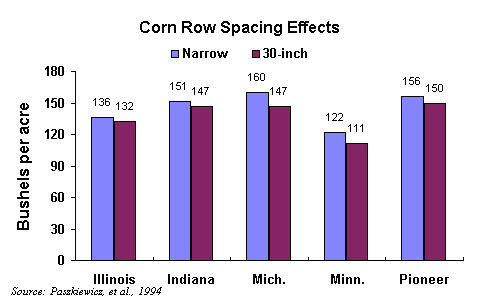 Fig. 1.
Fig. 1.A closer look at the Pioneer Hi-Bred data reveals the variability in yield response from site to site (Fig. 2). In studies conducted throughout Iowa, Minnesota, North Dakota, and South Dakota with four hybrids per site, yield increases for 22.5-inch rows versus 30-inch rows ranged from zero to nine percent. The variability did not seem to be influenced by latitude, hybrid, yield level, or population.
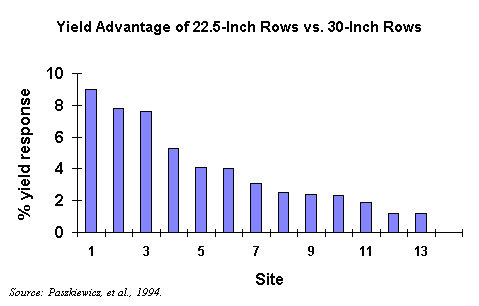 Fig. 2.
Fig. 2.Research conducted by Garren Benson, Iowa State University, in 1995 showed similar small yield responses to 15-inch row spacings compared to 30-inch row spacings when grown at comparable populations (Fig. 3). The research was conducted at four locations throughout Iowa.
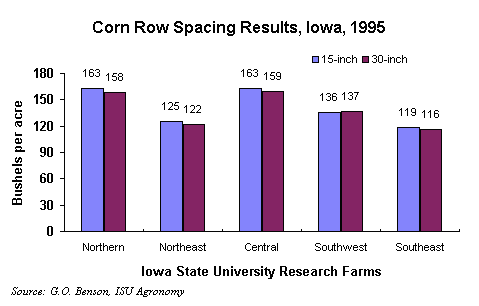 Fig. 3
Fig. 3Deere & Co. (Gray, 1997) recently conducted a survey of researchers throughout the U.S. CornBelt who have evaluated the influence of narrower row spacings on corn grain yield. The summary of this survey supports my earlier observation that the most positive yield effects due to narrower rows are found in the northern CornBelt (Fig 4). The zones listed in the graph correspond approximately to
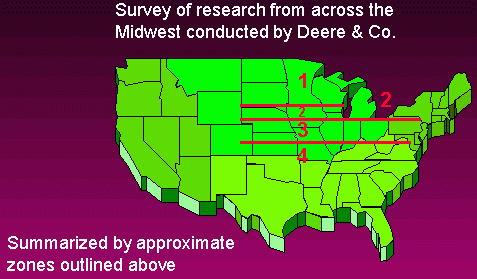
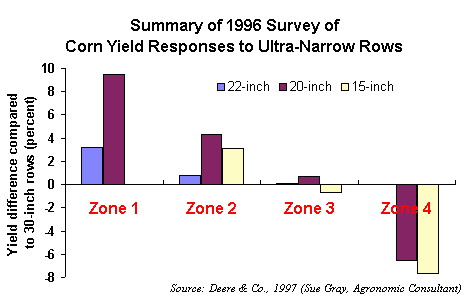 Fig.
4
Fig.
4Numerous farmers have reported 'success' in switching to row spacings less than 30-inches. However, it is often not clear from the manner in which these testimonies are reported in the farm press whether actual comparisons were made between the narrower rows and the original, wider rows. In addition, some farmers not only switch to narrower rows but also increase seeding rates in anticipation of the benefits of 'spreading out' the plants more uniformly with the narrower rows. Consequently, some of the reported 'success' stories of narrower rows may be confounded with yield increases due to higher plant populations. Some of these farmers may have been able to achieve the yield response simply by increasing their plant population in the first place, without switching to narrower rows.
Logic dictates that narrower rows will allow quicker canopy closure and thus quicker shading of the ground. Weed control may be improved by such earlier shading, but there is little hard evidence to support this in corn. The disadvantage to narrower rows is that mechanical cultivation for weed control is more difficult, if not impossible. Even post-emergence herbicide treatments are made more difficult by narrower rows. Remember, corn will not tolerate being driven over as well as soybeans do.
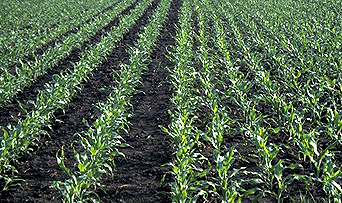
Some growers want one planter for two or more crops.
However, growers with no-drill drills for soybeans and wheat may not want to give them up.
Remember, that the costs of switching to narrowers rows goes beyond that of the planter itself.
![]() Return to The Corn Growers Guidebook , a WWW
resource for corn management systems in Indiana and the eastern CornBelt.
Return to The Corn Growers Guidebook , a WWW
resource for corn management systems in Indiana and the eastern CornBelt.
![]() Purdue University Agronomy Extension WWW
Home Page.
Purdue University Agronomy Extension WWW
Home Page.
![]() Purdue Agronomy On-Line! , Purdue's
Agronomy Department WWW Home Page.
Purdue Agronomy On-Line! , Purdue's
Agronomy Department WWW Home Page.
End of Document